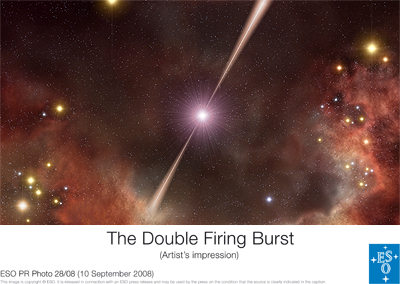GRB 080319B was so intense that, despite happening halfway across the Universe, it could have been seen briefly with the unaided eye. In a Nature paper, Judith Racusin of Penn State University, and a team of 92 co-authors report observations across the electromagnetic spectrum that began 30 minutes before the explosion and followed it for months afterwards.
"We conclude that the burst's extraordinary brightness arose from a jet that shot material almost directly towards Earth at almost the speed of light - the difference is only 1 part in 20 000," says Guido Chincarini, a member of the team.
Gamma-ray bursts are the Universe's most luminous explosions. Most occur when massive stars run out of fuel. As a star collapses, it creates a black hole or neutron star that, through processes not fully understood, drives powerful gas jets outward. As the jets shoot into space, they strike gas previously shed by the star and heat it, thereby generating bright afterglows.

The team believes the jet directed toward Earth contained an ultra-fast component just 0.4 degrees across (this is slightly smaller than the apparent size of the Full Moon). This jet is contained within another slightly less energetic jet about 20 times wider.
The broad component is more typical of other bursts. "Perhaps every gamma-ray burst has a narrow jet, but astronomers miss it most of the time," says team member Stefano Covino. "We happened to view this monster down the barrel of the very narrow and energetic jet, and the chance for this nearly head-on alignment to occur is only about once a decade," added his colleague Cristiano Guidorzi.
GRB 080319B was detected by the NASA/STFC/ASI Swift satellite towards the constellation of Boötes, the "Herdsman". A host of ground-based telescopes reacted promptly to study this new object in the sky, including ESO's Very Large Telescope, which was the first to provide the distance of the object, 7.5 billion light-years. The visible light from the burst was detected by a handful of wide-field cameras worldwide that are mounted on telescopes constantly monitoring a large fraction of the sky. One of these was the TORTORA camera mounted on the 0.6-m REM telescope at ESO's La Silla Observatory (ESO 26/07).
TORTORA's rapid imaging provides the most detailed look yet at the visible light associated with the initial blast of a gamma-ray burst. "We've been waiting a long time for this one," says TORTORA senior scientist Grigory Beskin of Russia's Special Astrophysical Observatory. The data collected simultaneously by TORTORA and the Swift satellite allowed astronomers to explain the properties of this burst.
Article: Racusin, J. L. et al. 2008, Broadband observations of the naked-eye gamma-ray burst GRB 080319B, Nature, 11 September 2008.





Comments